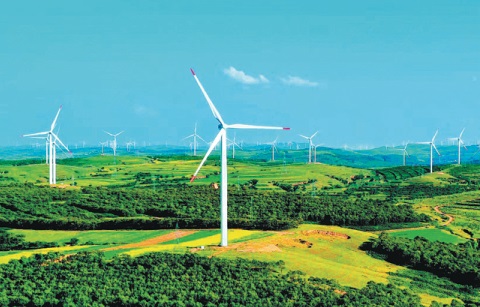
Photo: Forests and grassland now cover the once barren mountains and hills of Youyu county, Shanxi.
China will make crucial adjustments to its greening plan in the next five years, aiming to achieve high-quality greening nationwide and guide related work more scientifically, authorities revealed on Monday.
The State Council recently released guidelines on scientific greening that said protection and natural restoration will play major roles in the country’s greening work between 2021 and 2025.
The guidelines emphasized the importance of making greening plans that give consideration to local climatic conditions and water resources, encouraging arid areas to make low-water-cost afforestation plans to prevent the wasting of water.
They also recommended that local governments choose more local plants, rather than imported species, for greening, as local plants are better acclimated and don’t need to be transported as far, which saves money.
The guidelines also urged local governments to strengthen the management of greening projects and make resolute efforts to protect local wild plants, endangered wild species and the habitats of wild animals.
The importance of making greening projects practical was also noted, such as encouraging the use of low-cost greening plants that consume less water.
“We should respect the laws of nature and make a stand against ‘good-looking’ plants, such as transplanting big trees from the suburbs to the city center,” they said, adding that the problem of willow and poplar catkins, which can cause allergies, should be further addressed.
“We will aim to conduct greening more scientifically, which plays a crucial role in improving the country’s environment and the state’s biosecurity,” said Liu Dongsheng, deputy director of the National Forestry and Grassland Administration.
“It will also contribute to our plan of building a beautiful China and also meeting climate objectives.”
Through decades of persistent efforts, China’s forest coverage now stands at 23.04 percent of its land area, according to the administration, while its grassland comprehensive vegetation coverage hit 56 percent last year.
The country currently has 220 million hectares of forest with a total forest stock volume of 17.56 billion cubic meters. Total forest stock volume is often used for forest resource management and planning and as a predictor of carbon-related variables.
The per capita green area in China’s urban areas averages 14.8 square meters and 441 cities have joined in a campaign to build national forest cities through multiple greening methods.
The country initiated its first pilot program to construct grassland nature parks last year, with 39 pilots launched covering a total of 147,000 hectares of grassland in 11 provinces and autonomous regions.
“In past years we’ve found some green projects that were poorly designed and went against the laws of nature,” Liu said. “Some cities even destroyed their local environment in the name of greening projects. Scientific greening came in time and is very meaningful for guiding future work.”
Under the guidelines, greening plans will be listed in the country’s new territorial spatial plan, which is expected to be released soon. In the future, the processing of applications for greening land will be stricter, said Zhou Yuanbo, head of the Ministry of Natural Resources’ ecological restoration department.
Data on all the country’s greening projects will be collected by natural resources departments at all levels, according to the guidelines. Surveillance will be conducted annually to make sure all the projects are conducted properly.
“The strictest regulation will be implemented to prevent farmland from being illegally used for greening projects,” Zhou said. “Neither lakes nor oceans will be allowed to be filled in the name of greening, and the illegal exploitation of mountains is also prohibited.”
Source: Qiushi Journal, 2021-06-09
Leave a Reply
You must be logged in to post a comment.